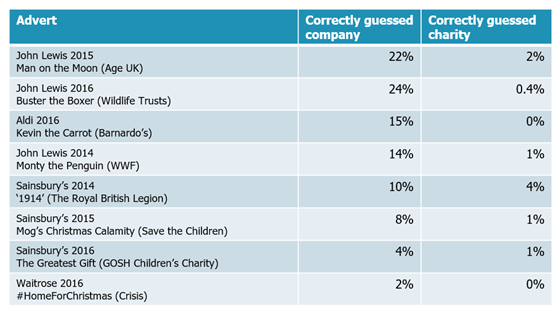Christmas ads. The sign that the festive period has begun. Many marketing campaigns this year centre around the need for a Christmas surrounded by loved ones after the hardship of the pandemic and a Christmas in isolation for many in 2020. The last 18 months also mean everyone is even more in need of some feel-good festivities and heart-warming positivity. Christmas is for kindness and goodwill, so it comes as no surprise each year when we see a flurry of cause driven advertising hit our screens. Partnerships between charities and major corporations go hand in hand at Christmas and purpose-driven marketing is rife. So, how are charity partnerships featured in Christmas ads this year?
Let’s kick off with the Christmas ad that we all wait for with anticipation – the John Lewis Christmas ad. This year John Lewis have continued their partnership with FareShare and Home-Start, donating 10% of the profits from the sale of its Christmas sweaters. This year, this support is vital given that since the pandemic started FareShare has reported having to double the amount of food it distributes to meet the rising demand. However, viewers wouldn’t know of this partnership from the ad. In last year’s ‘Give a Little Love’ advert Home-Start and FareShare’s logos were flashed up for a second, this year nothing.
Of all those I’ve seen so far this year I have to say that Aldi’s tale of Ebanana Scrouge has to be my favourite. An animated fruit twist on Charles Dickens’ classic A Christmas Carol - brilliant. This year, Aldi has partnered with Neighbourly to donate surplus food from its stores, though only keen eyes would know it given the minuscule charity logo shown on the side of a wagon and for a second at the end (though I must admit I didn’t see the logo until the second or third watch). Perhaps Marcus Rashford’s cameo as ‘Marcus Radishford’ and sprouts delivering crates of food tries to put focus on food poverty and bring recognition to the invaluable role that he played over the pandemic.
Completely on the other end of the spectrum, when it comes to the promotion of a charity partnership, is Co-ops Christmas ad with Community Fridges – though this doesn’t really feel like an ad at all. More like a segment on a morning talk show, Dermot O’Leary walks viewers through the scheme, giving this Community Fridge 100% of the airtime. What a great way to turn the traditional, expected Christmas ad on its head to promote an invaluable cause.
Many corporates have chosen to partner with charities working in causes that were particularly exacerbated by the pandemic. John Lewis, Aldi, and Co-op keep a much-needed focus on food poverty exacerbated by the pandemic. Others, including ITV and Walkers, have focused on mental health and wellbeing. ITV’s Christmas ad features many well know faces and is a comical reminder to give someone your ear this Christmas. Their campaign ‘Britain Get Talking’ supported by Mind and YoungMinds is featured on the end screen and the important message behind the marketing campaign highlights mental wellbeing. Promoting a similar message, a voiceover tells viewers about Walkers and Comic Relief’s pledge to give £2 million to mental wellbeing programmes in their Christmas ad. At least this partnership is given a few seconds of airtime.
For most of these charities, airtime of their involvement in partnerships is minimal and often only acknowledged with a quick logo at the end. Are charities getting enough recognition from partnerships with corporate companies over the Christmas period? Our research suggests not.
In 2017, we surveyed the general public, showing them stills of 8 Christmas ads that had been broadcast between 2014 – 2016, and asked half if they could remember the company involved and the other half the charity. Do you remember the 2015 Christmas Ad ‘Man on the Moon’? I know that’s now a while ago, but I definitely remember shedding a tear for the old man alone on the moon and the kindness of the little girl on Earth. Well, we found that 22% of the public correctly remembered that this was a John Lewis ad - only 2% remembered that the charity partner was Age UK. Of the Christmas ads we prompted, the charity partner for Sainsbury’s ad ‘1914’ was most remembered – even then only 4% of people knew that this was a partnership with Royal British Legion. Perhaps the ad's war theme had a hand in bridging that link in the minds of the public. Up to 1% of people remembered the charity partner in the other six ads, all of which are household name charities and are near universally known, including WWF, Save the Children, and Wildlife Trusts.

Though there was also very low recall of the company behind certain ads, people were much more likely to remember the company than the charity. Funding and support created through corporate partnerships is of course the standout objective, but an advert is a brilliant way to increase exposure for charities where advertising & marketing funds are much more limited than large corporates. This research shows that the promotion of these partnerships is widely not getting through to the public, at least not nearly enough for them to remember a charity. The emotional storytelling of Christmas ads is a great way to raise awareness for the issues that charities work on, but charities can’t rely on much exposure from corporate partnerships.

